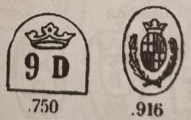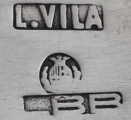EUROPEAN COUNTRIES SILVER AND GOLD HALLMARKS
SPAIN
A silver or gold object that is to be sold commercially is, in most countries, stamped with one or more hallmarks indicating the purity of the metal and the mark of the manufacturer or silversmith
The word "HALLMARK" derives from the fact that, since the 16th century, precious metals were sent to the London Goldsmiths' Hall for testing to ensure that the correct standard of silver had been used. The Goldsmiths' Hall was the headquarters of the Goldsmiths' Company and the home of the Assay Office.
In some countries, the testing of precious metal objects and marking of purity is controlled by a national assay office.
Depending on the national legislation the use of hallmarks may be compulsory, voluntary or provided by a manufacturer's declaration.
The present Spanish hallmarking system is organized on a voluntary base.
|
SPAIN
In 1881 Spain adopted the metric system approving the use of silver fineness 750, 800, 900 and 916/1000. The absense of the the corresponding regulation caused a legal vacancy which lasted until 1934. In the meantime, in most cases, low title was used in silver making. Only on request, fineness was certified by an assayer using hallmarks for 750 and 916/1000 silver.


In 1934 the Spanish hallmarking system was organized on three types of marks:
- fineness mark, in the form of a "five-point star" for 915/1000 purity (plata de ley) and a "six-point comet" for 750/1000 purity (plata de segunda)
- maker's mark in a hexagonal contour
- assay office code, as a letter code stamped in the fineness mark star (this code was rarely used)


left: .915 fineness after 1934 right: .750 fineness after 1934
 1 1
 2 2
 3 3
1: .915 fineness mark after 1934 2: .915 fineness mark after 1934 with Barcelona Assay Office letter (B) 3: .750 fineness after 1934
|



Spanish maker's marks on silver items manufactured in Spain (hexagon) and abroad (triangle):
the number is the maker's registration number. The letter is the Assay Office code
|

|
From 1988 the standard mark is a rectangle containing the fineness number.
The fineness is accompanied by the Assay Office letter code
and the number "1, 2, 3 or 9" just over the right upper corner of the rectangle.
In 2002 the system was reformed and the alphanumeric code moved inside the rectangle.
|

|
Spanish Assay Offices are identified with the number "1"
with the exception of Baleares identified with the numbers "B2, B3, B9",
Castilla-Leon "CL1, CL2" and Cataluna "C1 and C2"
|

www.silvercollection.it |
This is a page of 'The What is? Silver Dictionary' of A Small Collection of
Antique Silver and Objects of vertu, a 1500 pages richly illustrated website offering all you need to know about
antique silver, sterling silver, silverplate, Sheffield plate, electroplate silver,
silverware, flatware, tea services and tea complements, marks and hallmarks, articles,
books, auction catalogs, famous silversmiths (Tiffany, Gorham, Jensen, Elkington),
history, oddities ...
HOME - SITE MAP - SILVER DICTIONARY - COOKIES CONSENT AND PRIVACY |
| |